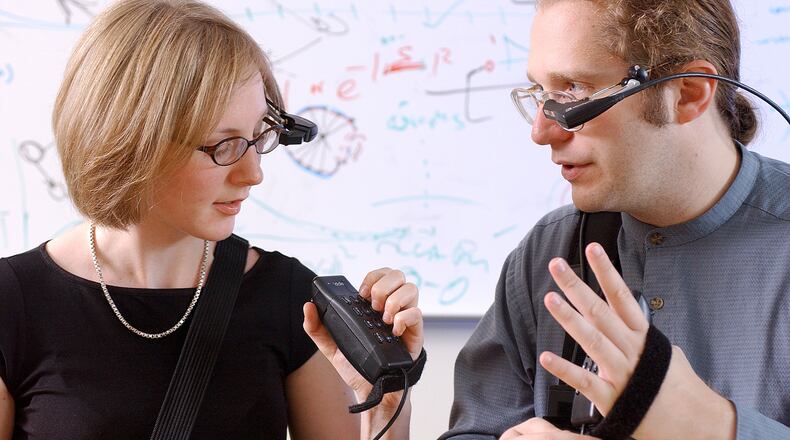Glass in hand
This weekend Google is giving demos to potential buyers of Glass, the company’s wearable computer.
Where: The Foundry at Puritan Mill, 916 Joseph E. Lowery Boulevard NW, Atlanta, 30318.
When: Saturday and Sunday, 10 a.m. to 6 p.m.
Price: The event is free; Glass is priced at about $1,500 — potentially more with prescription lenses.
Technology and You
The Atlanta Journal-Constitution keeps you up to date on the technologies that are changing our lives — from the connected car and digital home to emerging cyber-security threats. Today, visit the frontiers of wearable computing with a pioneering Georgia Tech professor.
Technology and You
The Atlanta Journal-Constitution keeps you up to date on the technologies that are changing our lives — from the connected car and digital home to emerging cyber-security threats. Today, visit the frontiers of wearable computing with a pioneering Georgia Tech professor.
He was sweating it out.
Nearly two decades ago — before search engines or smartphones — Thad Starner, then 24, sat in front of a qualifying panel at the Massachusetts Institute of Technology. For several hours he was grilled by four professors, a prerequisite before he could write his Ph.D thesis.
At the end, one of his inquisitors asked: Hey, Thad, were you using your wearable computer?
Starner, clad in a get-up that covered his left eye with wires leading down to a keyboard on his forearm, plus a satchel holding a battery pack and a measly 80 megabyte hard drive, said: Yes.
His answer touched off a half-hour debate that almost culminated in MIT conferring its degree on “Thad Starner and his computer.” That, sadly, did not come to pass.
“It would have been hilarious,” the 44-year-old, now on faculty at Georgia Tech, said in hindsight.
Starner’s work at MIT’s Media Lab would later lay some of the groundwork for Google Glass. Since 2010, he been a technical lead for the project, as well as the founder and director of the Contextual Computing Group at Georgia Tech’s College of Computing.
He was one of the people to wear the first iteration of Google’s wearable computer — which he found a distinct improvement on his earlier model. (He did, though, have to cut his shoulder-length hair in order to wear it comfortably.)
He now wears the latest version, in light blue, fitted with his prescription lenses.
This weekend Google is bringing the circus to town, inviting regular folks to try on Glass at the Foundry at Puritan Mill.
The two day event is the fourth stop on the search engine’s campaign to make people more comfortable with the $1,500 devices. Google hopes the tour will help dismiss some of the Orwellian perceptions that have surrounded the device over the past year.
Glass wearers look up into a translucent heads-up display (not unlike that of a fighter pilot), where information is displayed. The device is based on more than a half-century’s worth of research, dating back to 1945.
Google would like you to think about Glass like this:
The cloud is forever. Your laptop is a place where you can hold information for months or years. Your smartphone is for stuff you want to keep for a week.
But wearable computing, an emerging category that includes Glass, is for right now — the Random Access Memory (RAM) of our lives.
Glass — in fact all wearable computing — is meant to function almost as an extension of the wearer’s nervous system. In effect, Starner is a beta site: a trial run for of what a computer-enhanced human might look like.
He’s been taking computerized notes on nearly every important conversation he’s had since at least 1993; asked about something from his past, he uses Glass to retrieve the notes.
(Wearers use a combination of eye and head movements and spoken commands to access information and perform other operations on the Glass computer.)
The stories Starner tells about the people he’s met and places he’s been come out in encyclopedic bursts. No chronology. Just search-engine-like depth and speed. Jumping from one subject in 1995 to another in 2008.
In the midst of talking to you, he looks up, responding to an incoming alert. He stares into space, reading material returned in his latest web search. His eyes flick upward; he’s gotten an email. You get the gist.
It sounds strange, but it’s actually meant to be less intrusive than having the person you’re talking to constantly dive into their cell phone to handle the same range of tasks.
On Thursday night, during a last-minute Google Glass-sponsored Design Sprint on the sixth floor of the Centergy Building in Midtown, four Google development specialists chatted about the ins-and-outs of creating software for Glass.
The gathering drew roughly a 100 Georgia Tech students, programmers and designers (some cool enough to wear both Glass and green pants).
That kind of buy-in from the development community is critical, especially if Glass is to take off. No one company has the ability to fill the needs of all mobile Internet users.
To hear the Google folks tell it, Glass is almost like a silent librarian.
It shouldn’t interfere with the actions of the user. Glassware (as Google calls its brand of wearable computing apps) should only give gentle reminders and directions.
To refine the user experience, Google has been testing its foray into wearable computing for the past year on Glass Explorers.
That’s a group of early adopters who were originally chosen from a pool of roughly 150,000 applicants. Each explorer paid $1,500 for the privilege of being a test subject, a price point that is unlikely to fall anytime soon.
Their ranks have grown from 8,000 at the onset to roughly 10,000.
“‘When you concentrate on the hardware, the software you get creates bad interactions,” said Starner, sitting toward the back of the room. He wore a Mandarin-style shirt buttoned to the top, a dark sports coat and black jeans.
“And when you start with the human and design the software around the person, it works very well.”
Sitting on a couch at the edge of the space, a millennial — a digital native, maybe a Google employee, herself — stared up into the bifurcated Glass screen, which might have been displaying an important text message, just out of her normal line of vision.
After a moment, she gracefully shifted her attention back to the presentation, but then a real interruption intruded. She darted from the room to answer a smartphone call.
Glass is set to be released to the masses later this year.
About the Author
Keep Reading
The Latest
Featured



